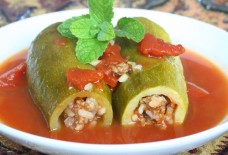The Yemeni Cooking Pot
By: Menal Elmaliki / Arab America Contributing Writer
In the hot kitchen of Yemen cafe, the chef is making one of Yemen’s most famous dish, salta. He cooks the salta in what seems to be an unusual pot. In the fiery blaze, the stone looking pot is bubbling a savory fragrance, an intoxicating mix of spices. The waiter then serves the boiling hot stew to the hungry customer. The phantom smell of what went on behind the scene lingers. The customer eagerly dips his bread in the salta and burns his wee finger. He now requires medical attention and is suffering from 3rd degree burns.
This unusual pot is made of soapstone and is an essential aspect of Yemeni cuisine. Yemeni restaurants serve food in these traditional pots to keep the experience alive and of course food doesn’t taste the same without it.
Soapstone cookware is becoming increasingly popular in American cooking. Some call it rustic, others exotic but for Yemenis this is the sine qua non. This soapstone cookware is called harada, madra or rizah and they are the lifeblood of Yemeni cuisine. It is a thick-walled stone pot that you will find in every Yemeni household.
Whenever I use these pots I am reminiscent of my childhood, of me waking up every morning and enjoying a Yemeni breakfast of foul or shakshouka. My mother would constantly remind us to be careful with it. My sister had dropped one once and we never head the end of it.
In the case of Yemeni cooking, you can’t have one without the other, the harada is as famous as the food it is cooked in. It is used to make saltah, fahsa, fatah (susi), shakshouka, and foul.
This special stone can only be found underground. It is unearthed 30 meters underground. The stone is mainly found in Sa’da Yemen, in the mountains of Razih.
These pots are not manufactured, it is individually carved using files and adzes. You can tell by the imperfections which reflects its naturalness. Since it is made from natural rock the surface is easy to scratch. Underneath the easy scratchable stone is a harder stone, called magnesite. The tradition of using soapstone is common in not only Yemen but Brazil and north of Italy.
What sets Yemeni stone cookware apart is that it is thinner than others. It can withstand very hot temperatures which makes it the perfect cooking component. Harada is known for its malleability; it keeps food hot and cold. Your food will stay hot even when it is off the flame. It is versatile and can be cooked on top of the stove or in the oven. It retains heat so be careful not to eat immediately or you may end up like our eager customer.
Harada is known for
- Keeps food hot for a longer interval
- Gives food flavor
- Natural and safer to use
- Better for the environment
- Looks aesthetic
- Will last a lifetime (if you don’t drop it)
- Cooks food evenly, no hot spots
- Will cause 3rd degree burns
Harada is not commercially available. You can buy it from a local Yemeni market or you can steal it from your Yemeni friend’s house.
Now that I’ve told you the significance of this stone pot in Yemeni cuisine, check out this simple breakfast recipe.
References
Perry, Charles. “Soapstone: Cookware That Rocks.” Los Angeles Times, Los Angeles Times, 22 Feb. 2006, https://www.latimes.com/archives/la-xpm-2006-feb-22-fo-soapstone22-story.html.
Check out Arab America’s blog here!








